
A visitor to the centennial celebration of the United Hebrew Congregation in Joplin looks over plaques containing photos of religious leaders at this Jewish house of worship dating back to 1916.
A centennial celebration for the United Hebrew Congregation recently was held at the Jewish temple (a.k.a. synagogue) on S. Sergeant in Joplin. Many local residents took advantage of the opportunity to learn more about Reform Judaism, the more liberal denomination within Judaism to which the remaining small group of worshippers supports.
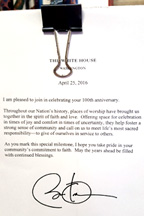 Proudly displayed is a letter bearing the signature of President Barak Obama. He says that he is "pleased to join in celebrating your 100th anniversary." He defines the role of places of worship and says at this special milestone to "take pride in your community's commitment to faith" and "may the years ahead be filled with continued blessings"
Proudly displayed is a letter bearing the signature of President Barak Obama. He says that he is "pleased to join in celebrating your 100th anniversary." He defines the role of places of worship and says at this special milestone to "take pride in your community's commitment to faith" and "may the years ahead be filled with continued blessings"
Promoted by Historic Murphysburg Preservation, Inc., the event last Sunday called attention to the work of architect Samuel Austin Allen whose skill left its mark on several other Joplin buildings, many that are listed on the National Registry of Historic Places. It should be noted that Allen's original temple design included a shiny dome that caught the eyes of travelers on Route 66 as well as a minaret. Unfortunately, in 1970 an electrical fire caused considerable damage to the building. The decision was not to replace the dome and minaret with insurance funds in favor of installation of central air conditioning.
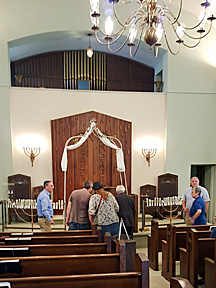 The interior of the temple is very tastefully decorated. Pews are wooden, the color of the walls institutional. The open area above the arc is where the cantor stands to sing liturgical music and lead the congregation in prayer. On the opposite wall, not pictured, is a balcony that is not needed, for only about 22 families comprise the temple membership. If the group still observed orthodox traditions the balcony would have been used for the seating of its female members.
The interior of the temple is very tastefully decorated. Pews are wooden, the color of the walls institutional. The open area above the arc is where the cantor stands to sing liturgical music and lead the congregation in prayer. On the opposite wall, not pictured, is a balcony that is not needed, for only about 22 families comprise the temple membership. If the group still observed orthodox traditions the balcony would have been used for the seating of its female members.
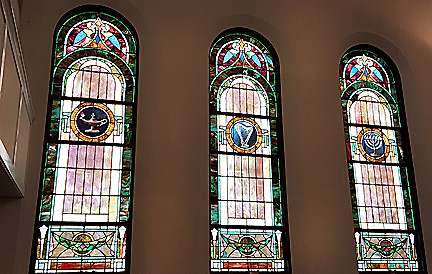
Stained glass windows, like these on the south side, line both sides of the place of worship. Slight color differences appear in areas that were repaired after the 1970 fire, but the overall beauty of the glass does not appear to have been affected.
Guests during the three hour event were able to tour the building including a stop in the rabbi's study. The congregation does not have a full time rabbi but instead has a Hebrew Union College student (who could be female) to conduct services alternating with members who have a thorough knowledge of Hebrew.
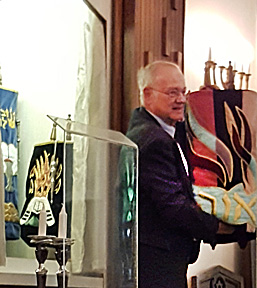 What must have been most interesting to visitors was when Jim Fleischaker, 2015-16 vice president, opened the wooden doors of the ark of the covenant and took out the smaller of the three scrolls containing the words of the Torah or religious instruction written in Hebrew. He said it was unusual for a small congregation to have that number. He then explained that the instrument attached called a "yad" was used as a pointer so that no fingers touched the parchment sections of the Torah.
What must have been most interesting to visitors was when Jim Fleischaker, 2015-16 vice president, opened the wooden doors of the ark of the covenant and took out the smaller of the three scrolls containing the words of the Torah or religious instruction written in Hebrew. He said it was unusual for a small congregation to have that number. He then explained that the instrument attached called a "yad" was used as a pointer so that no fingers touched the parchment sections of the Torah.
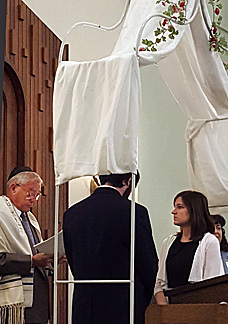 Emmy and Jerry Smith-Carpenter are shown as part of a mock wedding ceremony, exchanging vows in Hebrew. Also pictured is Alan Whitman who acted as the officiating rabbi.
Emmy and Jerry Smith-Carpenter are shown as part of a mock wedding ceremony, exchanging vows in Hebrew. Also pictured is Alan Whitman who acted as the officiating rabbi.
Two ceremonies were staged for visitors, including the traditional wedding ceremony and a bar mitzvah or the religious initiation of a Jewish boy who having attained the age of 13 becomes eligible to take part in public worship. Alan Whitman acted as rabbi in order to perform the mock wedding of Emmy and Jerry Smith-Carpenter. Defined were "ketubah" or marriage contract, a document rarely enforced that is meant to outline the rights and responsibilities of the groom, allegedly protecting the bride, "huppah" or canopy under which the couple stands, and "mazel tov" or what is said after the "breaking of the glass."
A bag full of candy was passed around and everyone was told to throw it at the couple. The tradition started with a service called an "aufruf," which originally was when a soon-to-be married bride and groom would be called up to the Torah to get an "aliyah," or "passing."
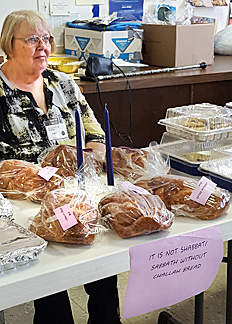 Diana Fleischaker was in charge of the sale of challah or braided egg bread as well as the Purim holiday treat hamantaschen. Jewish delicacies are difficult to find in stores in the Joplin area.
Diana Fleischaker was in charge of the sale of challah or braided egg bread as well as the Purim holiday treat hamantaschen. Jewish delicacies are difficult to find in stores in the Joplin area.
Activities simultaneously were being held in the large community room. A table full of Jewish delicacies provided by Mustard Seed Cuisine Catering was inspired by the Guide for Jewish Homemaker and Roberta Shilane, temple president. In another area visitors could purchase challah bread, blintzes and hamantaschen or triangular-shaped pastry filled with fruit.
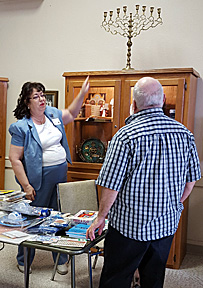 President Roberta Shilane provides a lesson in candelabras for a guest. She told him how the Menorah or Hanukkah lamp is a nine-branched candelabrum, one for each of the eight days of the holiday and a ninth holder called the "shamash" or "helper candle. The candelabrum with seven arms is symbolic of the State of Israel and the Jewish people and should not be referred to as a Menorah. For Reform Jews it represents seven days of the week.
President Roberta Shilane provides a lesson in candelabras for a guest. She told him how the Menorah or Hanukkah lamp is a nine-branched candelabrum, one for each of the eight days of the holiday and a ninth holder called the "shamash" or "helper candle. The candelabrum with seven arms is symbolic of the State of Israel and the Jewish people and should not be referred to as a Menorah. For Reform Jews it represents seven days of the week.
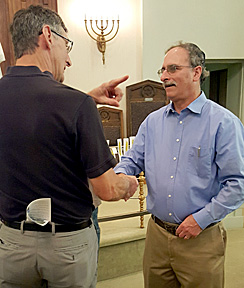 At right, Dr. Paul Teverow, a temple board member, greets a visitor. A Missouri Southern State University history professor, Teverow has been a long, ardent supporter of the congregation.
At right, Dr. Paul Teverow, a temple board member, greets a visitor. A Missouri Southern State University history professor, Teverow has been a long, ardent supporter of the congregation.
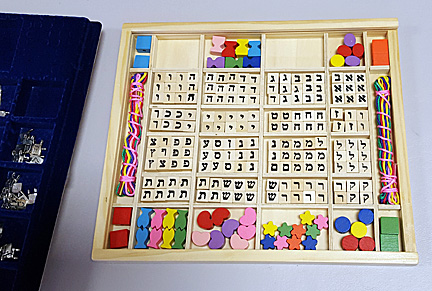
Games were also for sale like the popular dreidel and jewelry was being created from beads with Hebrew lettering that were used to translate English names.






Comments